What direction do solar panels have to being facing in the United States to get optimal performance?
Solar Energy Maps Canada (Every Province)
Published by Rylan Urban on May 12, 2018. Final updated Jan 25, 2021.
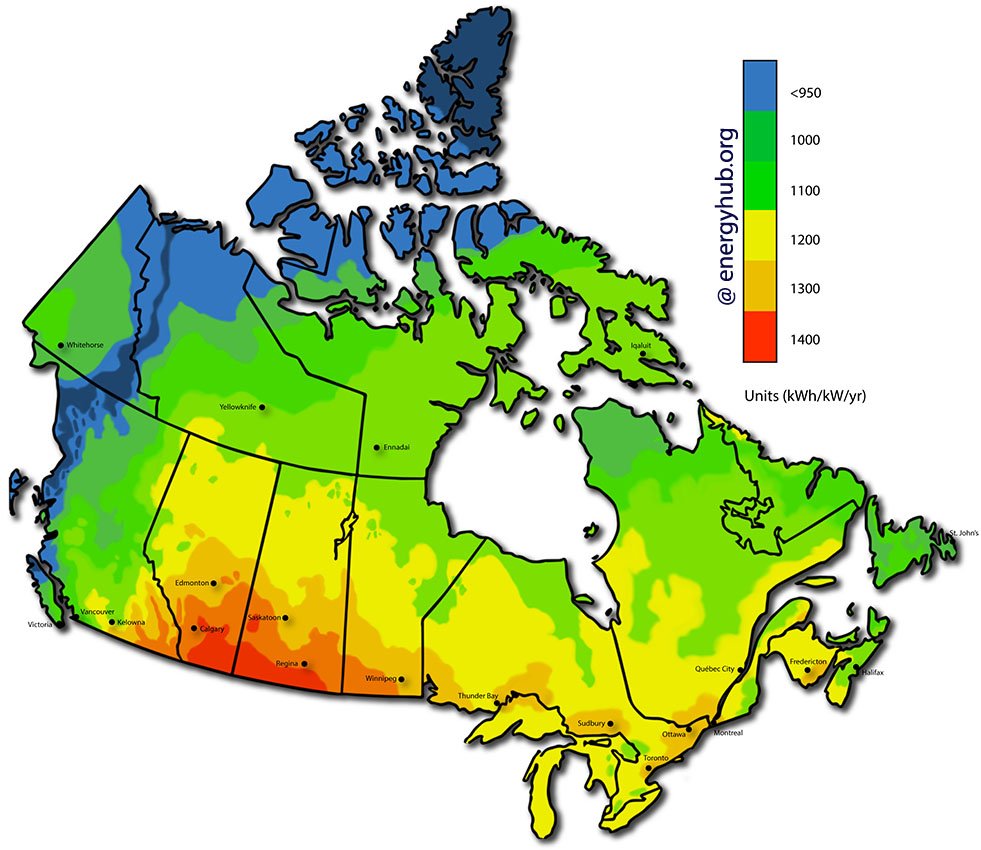
National Average Solar Energy Production Potential: 1133 kWh/kW/yr
This page contains solar energy maps, along with monthly solar production estimates, for every province and territory in Canada.
Solar free energy maps show the corporeality of free energy that a solar photovoltaic organisation can produce (in units of kWh/kW/twelvemonth), based on the intensity of light that reaches the World's surface.
Jump down to provincial maps
How to utilize Solar Energy Maps
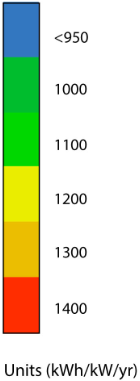
Solar maps tin be used to answer two key questions:
- Question 1: "How much energy (in units of kWh) can a solar power system (in units of kW) produce per year (yr) in my region?"
Answering this question is easy – but look at the value on the map or detect your metropolis below!
- Question 2: "What size of solar organisation volition I need to install (kW) to starting time my annual (year) electricity usage (kWh)?"
You can hands summate the size of the system that you would demand to starting time your almanac electricity usage, equally well equally your full arrangement costs, by visiting our Solar Toll of Solar page.
Solar Production Potential by Province
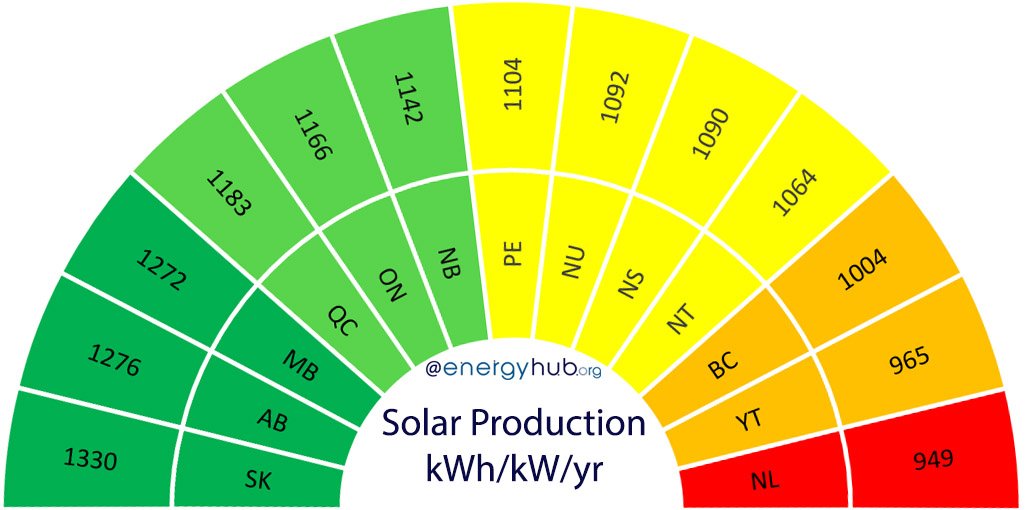
We've gone alee and calculated the average solar production potential based on the five almost populated cities for every province and territory in Canada.
This capacity to turn light into electricity is besides a major ranking cistron in our Provincial Solar Rankings.
Here is the annual boilerplate equivalent of full sunlight hours broken downwards by province:
| #1 Saskatchewan | 1330 kWh/kW/year |
| #2 Alberta | 1276 kWh/kW/yr |
| #three Manitoba | 1272 kWh/kW/twelvemonth |
| #4 Québec | 1183 kWh/kW/yr |
| #5 Ontario | 1166 kWh/kW/yr |
| #six New Brunswick | 1142 kWh/kW/yr |
| #7 Prince Edward Isle | 1104 kWh/kW/year |
| #viii Nunavut | 1092 kWh/kW/yr |
| #9 Nova Scotia | 1090 kWh/kW/year |
| #10 Northwest Territories | 1064 kWh/kW/yr |
| #11 British Columbia | 1004 kWh/kW/year |
| #12 Yukon Territory | 965 kWh/kW/twelvemonth |
| #13 Newfoundland & Labrador | 949 kWh/kW/twelvemonth |
| #14 Canada Average | 1133 kWh/kW/twelvemonth |
Canada's Best and Worst for Solar Energy
- The all-time provinces for producing solar free energy in Canada are all located on the prairies: Alberta, Manitoba, and Saskatchewan.
This is because these provinces have relatively sunny weather all twelvemonth around.
- The worst province for producing solar energy in Canada Newfoundland and Labrador, while the worst territory is the Yukon.
This is primarily because of high almanac cloud cover in Newfoundland and Labrador, and a combination of high latitude (shorter summertime days) and cloudy weather in the Yukon.
- The best place in Canada for producing solar power is Torquay, Saskatchewan (which has a solar free energy potential of 1384 kWh/kW/yr), while the worst place is at the small research base located in Eureka, Nunavut (780 kWh/kW/yr).
- The best month for producing solar free energy in Canada is April when days are mid-length and skies are clear. The worst month for producing solar free energy in Canada is December when days are short.
Provincial Solar Free energy Maps
Saskatchewan
The boilerplate solar power organisation in Saskatchewan volition produce approximately 1330 kWh of energy per kW per year.
This yearly boilerplate decreases as yous move north and east in the province and increases as you lot motion due south and west. For instance, a 1kW solar system in:
- Saskatoon would produce about 1,350 kWh/yr
- Regina would produce near 1,361 kWh/year
- Prince Albert would produce nearly 1,300 kWh/year
- Moose Jaw would produce about 1,363 kWh/yr
- Lloydminster would produce 1,278 kWh/yr
Alberta
The average solar power system in Alberta volition produce approximately 1276 kWh of energy per kW per twelvemonth.
This yearly boilerplate decreases as you move n and w in the province and increases as you movement southward and east. For example, a 1kW solar system in:
- Calgary would produce about 1,292 kWh/yr
- Edmonton would produce about one,246 kWh/yr
- Cherry Deer would produce most 1,265 kWh/yr
- Lethbridge would produce about 1,330 kWh/twelvemonth
- Sherwood Park would produce i,246 kWh/yr
Manitoba
The boilerplate solar ability system in Manitoba will produce approximately 1272 kWh of energy per kW per year.
This yearly average decreases as you lot movement north and east in the province and increases as you move south and west. For example, a 1kW solar system in:
- Winnipeg would produce about 1,281 kWh/yr
- St. Claude would produce about 1,309 kWh/yr
- Brandon would produce about 1,341 kWh/yr
- Selkirk would produce about 1,267 kWh/year
- Dauphin would produce about i,303 kWh/twelvemonth
- The Pas would produce 1,202 kWh/yr
Québec
The average solar power organization in Québec volition produce approximately 1183 kWh of free energy per kW per twelvemonth.
This yearly average decreases as you move n in the province and increases as y'all move south.For example, a 1kW solar system in:
- Quebec City would produce about i,139kWh/yr
- Montreal would produce about 1,194 kWh/twelvemonth
- Laval would produce almost 1,199 kWh/twelvemonth
- Gatineau would produce about ane,103 kWh/twelvemonth
- Longue-Pointe-de-Mingan would produce 1,278 kWh/twelvemonth
Ontario
The average solar ability organisation in Ontario will produce approximately 1166 kWh of energy per kW per year.
This yearly average decreases as yous movement northward in the province and increases every bit yous move due south. For instance, a 1kW solar system in:
- Toronto would produce about ane,163 kWh/year
- Ottawa would produce about one,199 kWh/yr
- Mississauga would produce near i,160 kWh/yr
- Brampton would produce almost 1,155 kWh/yr
- Hamilton would produce 1,152 kWh/yr
New Brunswick
The average solar power organisation in New Brunswick will produce approximately 1142 kWh of free energy per kW per year.
This yearly average decreases equally yous motility north and w in the province and increases as you lot motion s and east. For example, a 1kW solar organisation in:
- Moncton would produce nigh 1,144 kWh/twelvemonth
- Saint John would produce about 1,133 kWh/yr
- Fredericton would produce almost i,147 kWh/yr
- Dieppe would produce about i,144 kWh/year
- Riverview would produce 1,141 kWh/yr
Prince Edward Isle
The boilerplate solar power organization in Prince Edward Island volition produce approximately 1104 kWh of energy per kW per year.
This yearly average decreases as you motility east in the province and increases equally you move w. For example, a 1kW solar system in:
- Charlottetown would produce about i,103 kWh/twelvemonth
- Summerside would produce about 1,125 kWh/year
- Stratford would produce about 1,100 kWh/year
- Cornwall would produce about 1,106 kWh/yr
- Montague would produce 1,087 kWh/twelvemonth
Nunavut
The average solar power system in Nunavut will produce approximately 1092 kWh of energy per kW per year.
This yearly average decreases every bit y'all move north in the province and increases as y'all move due south. For instance, a 1kW solar organisation in:
- Iqaluit would produce nigh 1,057 kWh/yr
- Rankin Inlet would produce nigh 1,150 kWh/year
- Arviat would produce well-nigh i,144 kWh/twelvemonth
- Bakery Lake would produce well-nigh 1,109 kWh/yr
- Igloolik would produce 999 kWh/yr
Nova Scotia
The boilerplate solar power system in Nova Scotia volition produce approximately 1090 kWh of energy per kW per year.
This yearly average decreases as you move n and eastward in the province and increases as you movement south and west. For example, a 1kW solar system in:
- Halifax would produce about 1,073 kWh/yr
- Dartmouth would produce about 1,076 kWh/yr
- Truro would produce near ane,095 kWh/yr
- Amherst would produce nigh 1,125 kWh/year
- New Glasgow would produce 1,081 kWh/yr
Northwest Territories
The average solar power system in the Northwest Territories volition produce approximately 1064 kWh of energy per kW per year.
This yearly average decreases every bit y'all move north in the province and increases every bit y'all move s. For instance, a 1kW solar organization in:
- Yellowknife would produce almost i,095 kWh/yr
- Hay River would produce about i,125 kWh/yr
- Inuvik would produce about 895 kWh/yr
- Fort Smith would produce almost 1,131 kWh/yr
- Fort Simpson would produce 1,076 kWh/yr
British Columbia
The boilerplate solar power arrangement in British Columbia volition produce approximately 1004 kWh of energy per kW per twelvemonth.
This yearly average decreases equally y'all move north and west in the province and increases equally you move south and east. For case, a 1kW solar arrangement in:
- Vancouver would produce about 1,007 kWh/yr
- Surrey would produce about 996 kWh/twelvemonth
- Burnaby would produce about 991 kWh/yr
- Richmond would produce about 1,027 kWh/yr
- Abbotsford would produce 996 kWh/yr
Yukon Territory
The average solar ability system in the Yukon Territory will produce approximately 965 kWh of energy per kW per yr.
This yearly average decreases equally you movement east in the province and increases equally you motion westward. For case, a 1kW solar organization in:
- Whitehorse would produce about 961 kWh/yr
- Dawson would produce about 1,027 kWh/yr
- Watson Lake would produce about 947 kWh/twelvemonth
- Faro would produce most 939 kWh/yr
- Carcross would produce 953 kWh/yr
Newfoundland & Labrador
The average solar ability organisation in Newfoundland & Labrador will produce approximately 949 kWh of energy per kW per yr.
This yearly average decreases every bit y'all move south in the province and increases every bit you move north. For example, a 1kW solar organisation in:
- St. John's would produce about 936 kWh/yr
- Formulation Bay would produce about 947 kWh/year
- Mount Pearl would produce near 933 kWh/yr
- Paradise River would produce about 977 kWh/yr
- Corner Brook would produce 950 kWh/yr
Methodology and External References
Solar production potential was calculated using the "hateful daily global insolation (kWh/m2 or full dominicus hours (h))" in Natural Resource Canada's photovoltaic potential and insolation dataset spreadsheet ("municip_kWh").
- We used values for a south-facing tilt where the installation angle equals degree breadth -15°.
- A 25% efficiency loss factor was then practical before getting the terminal kWh/kW/yr number.
- The elevation five populated cities from each province were used to summate province and territorial averages.
While the information presented on this page is accurate to three digits, the maps hither are intended to exist illustrative representations rather than a precise geographic information organization.
NRCan has an ArcGIS web mapping awarding which can be used to lookup data for whatever municipality in Canada, and an additional list of solar resource data sources here.
Other Sustainable Resource Maps (view only)
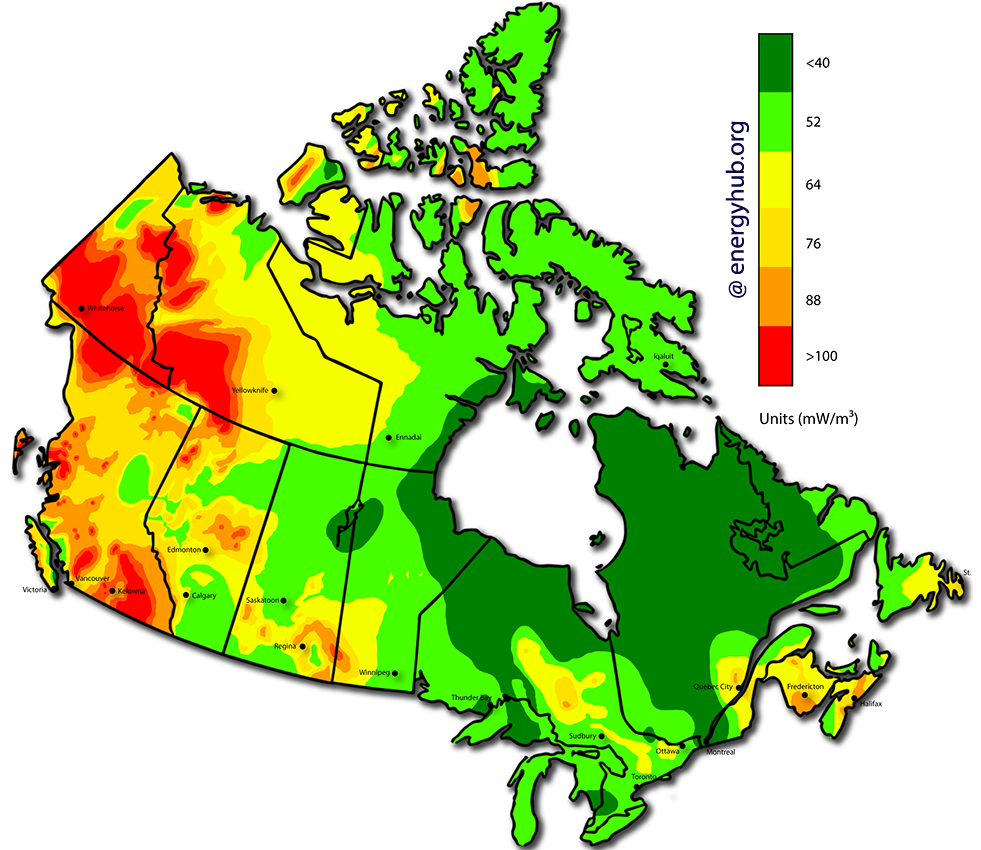
Geothermal Power
Geothermal power potential map mW/m³.
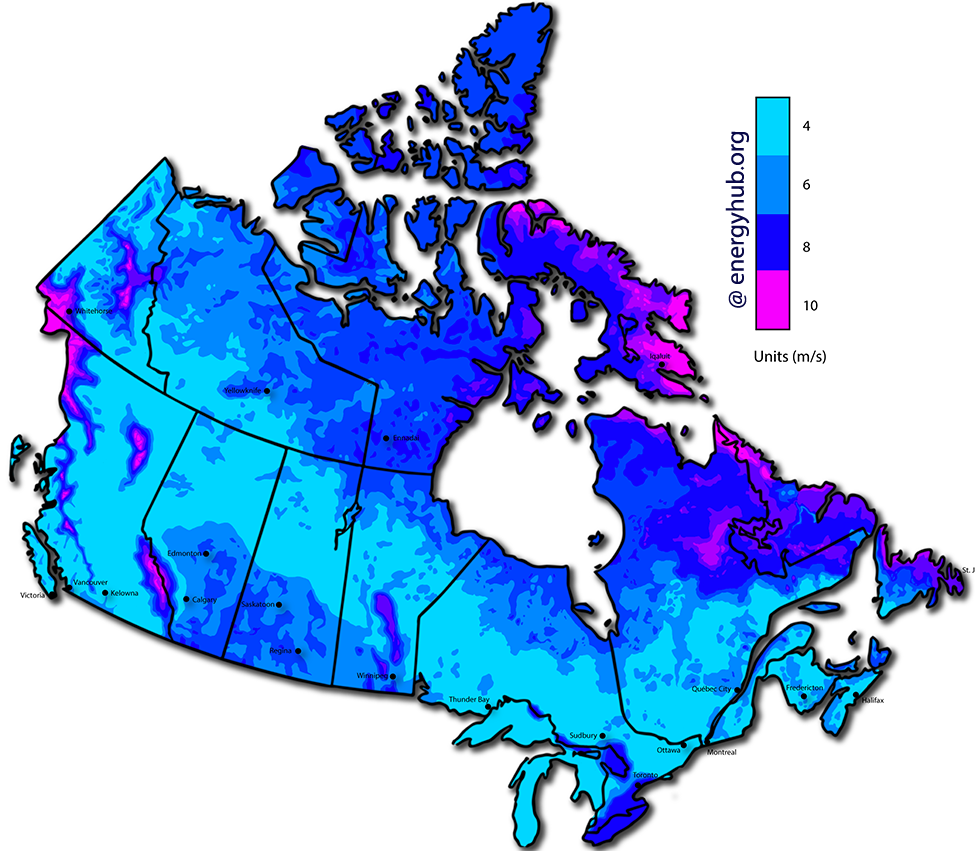
Wind Speed
Wind speed map (yard/s).
More Solar Energy Reference Guides
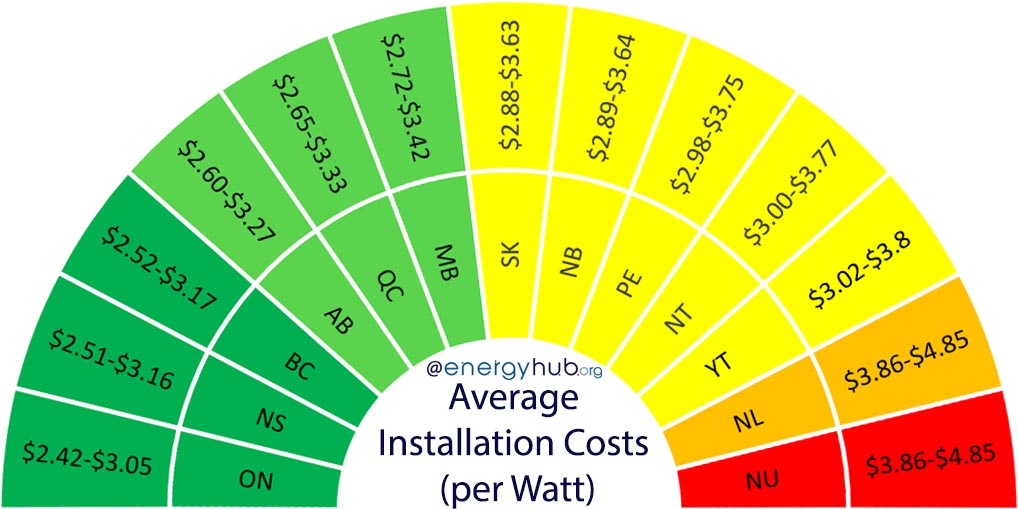
Toll of Solar Installation
Average cost of installing a solar system in every province and territory.
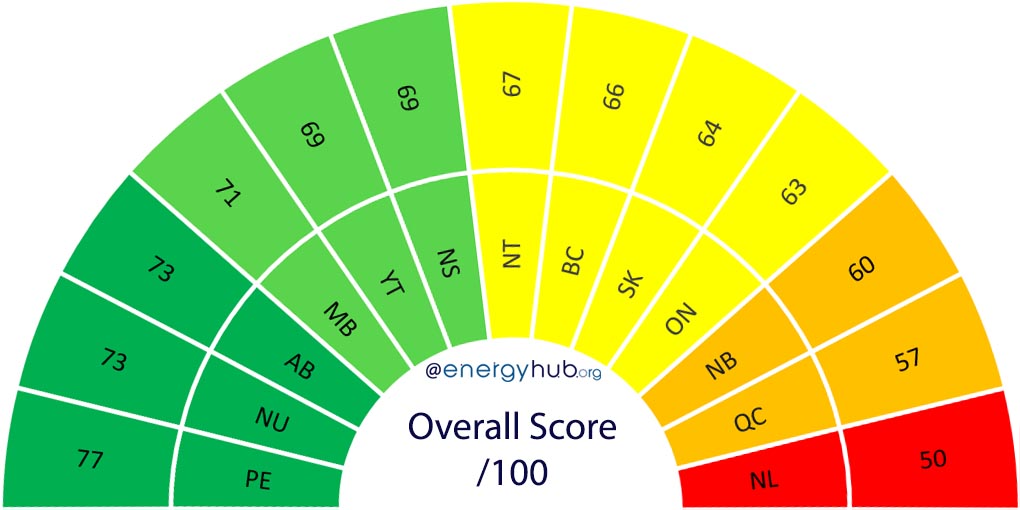
Provincial Solar Guides
Complete solar ability guides for every province and territory.
💜 Support us by sharing this page, bookmarking it for later, or referencing us online! 💜
chamberlandkied2002.blogspot.com
Source: https://www.energyhub.org/solar-energy-maps-canada/
0 Response to "What direction do solar panels have to being facing in the United States to get optimal performance?"
Post a Comment